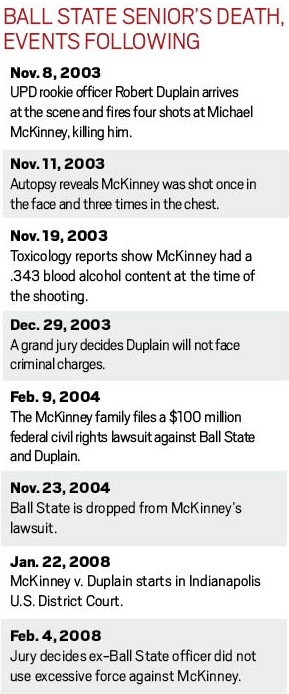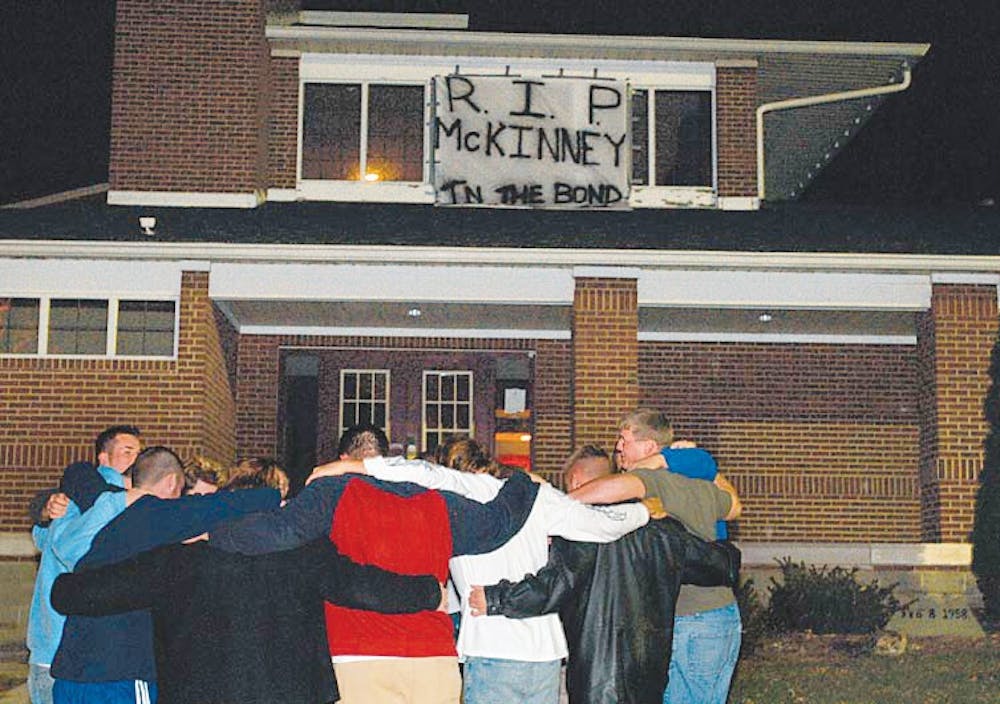
The University Police Department has made some changes in the 10 years since an officer shot and killed a Ball State student while responding to a robbery.
Tony Proudfoot, a university spokesperson, said now UPD requires new hires to complete a 15-week training program at the Indiana Law Enforcement Academy and a 15-week Field Training program at Ball State. This year, he said, university officers averaged 116 hour of training.
In 2012, Gene Burton, chief of police, told the Daily News that police officers have one year after being hired to attend the police academy, but he encourages them to go as soon as possible.
UPD received its first full Commission on Accreditation for Law Enforcement Agencies accreditation in December 2007 and again in 2011. According to a press release from 2011, receiving accreditation includes a 36-month self-assessment and complying with almost 500 standards.
On Nov. 8, 2013, four UPD officers responded to a burglary call around 3 a.m. at 1325 W. North St. Senior Michael McKinney was banging on the back door, trying to confuse his friends after a night of drinking.
Robert Duplain, a 24-year-old rookie officer, fired four shots, hitting McKinney three times in the chest and once in the head. According to police reports, McKinney charged Duplain and would not yield to the officer’s orders, and Duplain felt threatened.
It was later determined that McKinney was unarmed and had a .343 blood alcohol content.
A 2003 internal investigation and 2008 lawsuit found that Duplain followed police procedures.
According to Daily News reports, at the time of the incident, Duplain had not yet attended the police academy, but completed 24 hours of classroom instruction and 14 hours of field training. He had not been trained to use non-lethal weapons yet.
The $100 million lawsuit the McKinney family filed in November 2003 backed up the officer when a jury determined Duplain did not use excessive force and ended the legal battle in Feb. 4, 2008.
According to UPD’s Use of Force Policy in 2009, an officer has three levels of force to control a subject: No force tactics, such as verbal commands; less-than-deadly force, such as impact weapons; and deadly force, which includes firearms.
Deadly force can be used if the officer believes it is necessary and appropriate for the situation or if the officer’s life or others’ lives are threatened, according to the policy.
Since the 911 caller hung up the phone on dispatch, police did not know if McKinney was armed or not.
McKinney’s mother, Lisa, said she doesn’t think university police should carry firearms.
“I think it’s the responsibility of them to contact the local police force, who do this all the time and have more experience, but that hasn’t happened,” she said.
Proudfoot said officers are trained and certified to carry weapons, which is no different than other law enforcement agencies.
Friends of McKinney continue to question whether or not Duplain should have felt threatened.
“Mikey was not in any way intimidating,” his sister, Rosie, said. “If anything, the guy probably could have pushed him, and he would have fallen down to the ground and fallen asleep.”
Ben Brooks, his friend and fraternity member, said McKinney wasn’t a threat, even if he was drinking.
“I still cannot believe any of the stuff that was said about that night,” he said. “He was never an aggressive person, even in that state. It never added up to me.”
Campus’ outlook on UPD changed, said Nick Koesters, another of McKinney’s friends.
“There was a little bit of animosity toward the university and police departments because I feel like after that, they went into self-preservation mode,” he said. “They were backed into a corner. They were more concerned with protecting Ball State than reaching out and saying, ‘This is a horrible situation, but it’s got to be more horrible for you. You lost your son, what can we do to help you?’”
UPD has not yet spoken about the incident in 2003. Burton referred the Daily News to Proudfoot, as the department has since Proudfoot joined the university in 2007.
“I seem to remember a lot of students asking for an apology,” Jon Seidel, an alumnus and former Daily News reporter who followed the story, said. “And it’s a shame when something happens, and the people in charge can’t give an apology because they are in litigation. Sometimes, just hearing the words ‘I’m sorry’ means a lot. … Ten years out, I think it’s a shame that the police department can’t talk about this.”
Lisa McKinney said she didn’t hear anything from the university directly, except for when they sent her son’s diploma.
“I have to admit, my husband and I were not enamored by their response to us and the aftermath of this terrible tragedy, so we would wish more had been done,” she said. “We want to make sure no student ever has to fear for their life from their own campus police officers.”
Steven Williams and Sam Hoyt contributed to this story.





